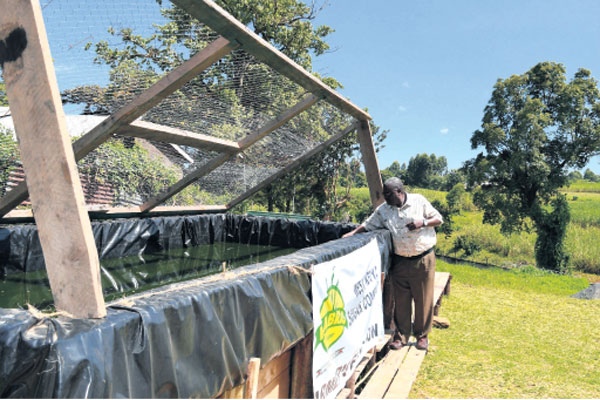Dickson Lucheli examines fish in a lockable pond on his farm in Kakamega . PHOTO | ISAAC WALE | NATION MEDIA GROUP
By JOHN SHILITSA
Dickson Lucheli walks to a fishpond on his farm in Kakamega County, extracts a key from his pocket and opens two padlocks in a structure.
He then lifts the cover made of wire mesh and timber to feed fish in the pond.
Lucheli is among farmers in the region who is keeping fish in lockable ponds that keep at bay predators such as snakes, tortoise, monitor lizards, birds and thieves.
His farm is in Namamali village, Kabras South and he has been keeping fish since the 1990s. His business received a boost in 2008 when the government supported fish farming through the economic stimulus programme, but predators handed him losses, frustrating his business.
He lost over Sh150,000 about two years ago when three of his ponds were raided and the fish stolen.
“I now have 12 earthen ponds on my one-and-half acres. The smallest measures 300 square metres and the biggest is 560 square metres.”
Lucheli is awaiting his first harvest from the new ponds.
A standard lockable fishpond costs Sh45,000. It is five metres long, two metres wide and one metre deep. The pond can host between 500 to 750 fish, fetching up to Sh140,000 in eight months.
The pond is made from timber, nails, a dam liner, chicken wire mesh for the cover and poles.
With the introduction of the lockable fishponds, Lucheli believes he will produce more fish to meet the demand from his customers.
“The ponds help farmers to control wastage since the feeds are not carried away by water unlike in earthen ponds whereby some feeds go to waste due to running water,” explains Kakamega County fisheries officer Jonathan Masava.
To clean the pond, it is refilled with fresh water after about a month-and-a-half.
“Fish defecate in water making it toxic. A farmer should monitor the water to ensure it does not suffocate the fish,” he says. The water is rich in nutrients, thus, good for farming.
Processing plants
West Kenya Sugar Company is educating farmers on how to use the structures. Head of agriculture Paramasivam Prabakaran says the company will help their sugarcane farmers set up a standard lockable fish pond on their farms.
Kakamega County has slightly over 8,000 fish farmers who own 12,000 fishponds. The county has a daily demand of between seven and 10 tonnes of fish, according to Masava.
“With a population of 1.9 million people, we need up to 20 million kilos a day to satisfy demand.” says Masava.
The county government, according to him, will install coolers in all sub-counties to enable farmers preserve their catch before delivering to fish processing plants.
Kenya’s total fish production stood at 193,106 tonnes last year, with at least 9,072 tonnes coming from the marine waters while aquaculture contributed 48,790 tonnes and the rest was from inland water bodies
CREDIT: NMG





No comments:
Post a Comment